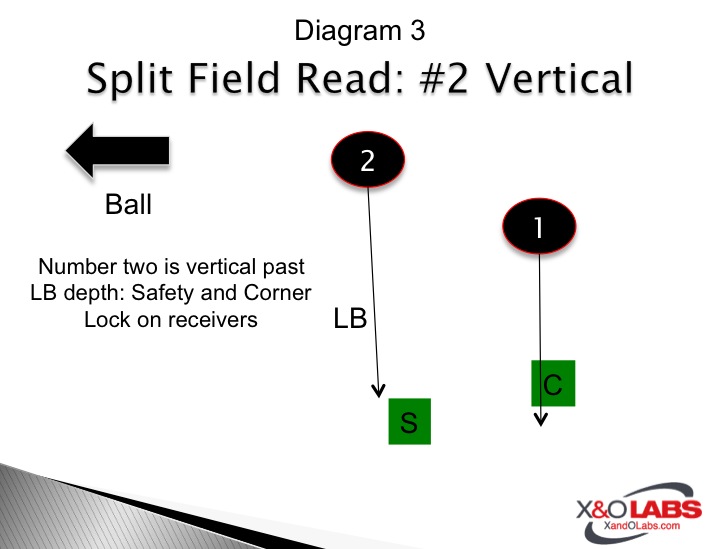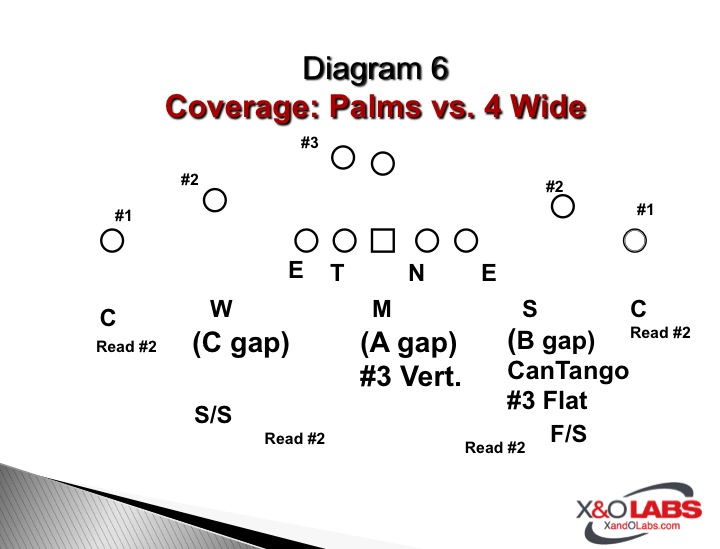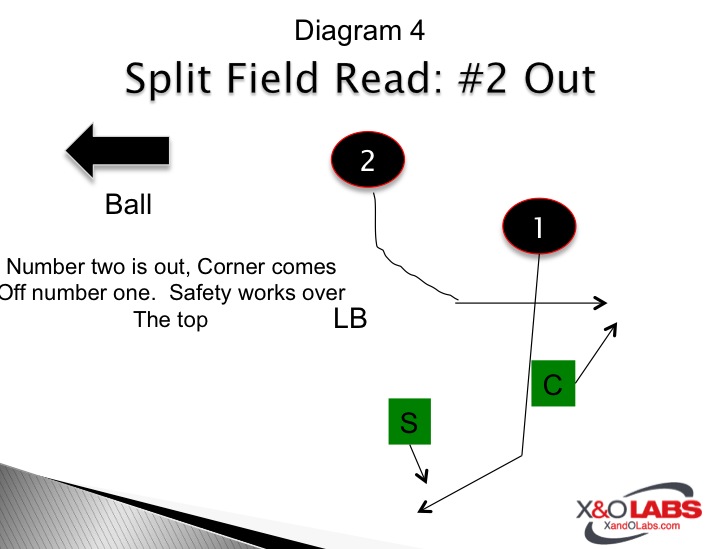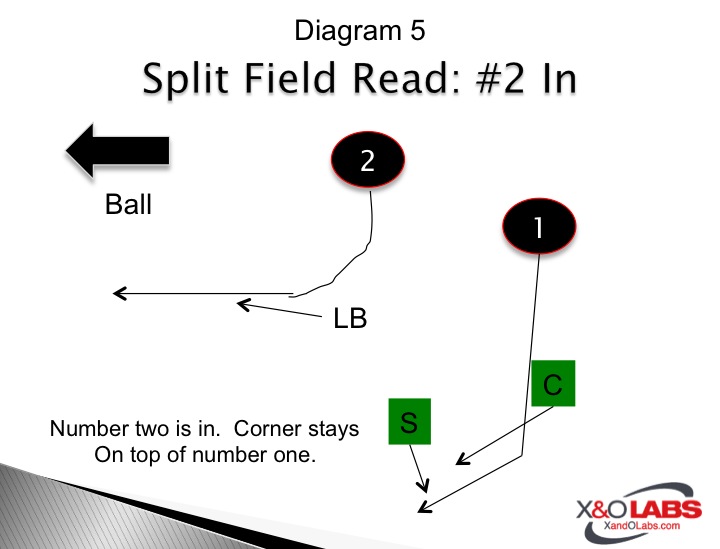By Mike Kuchar
Senior Research Manager
X&O Labs
Twitter: @MikekKuchar
Editor’s Note: The following research was conducted as part of X&O Labs’ special report on Quarters Coverage, which can be accessed by clicking here.
Two-Read Coverage Rules:
In this type of coverage, the Corner’s rules are simple:

Alert Call
Since it is the defensive backs making these adjustments on field, anytime the offense comes out with a detached number two receiver and could be a vertical threat, Shap Boyd, the defensive coordinator at Muskingum College, uses an "Alert Call" made by his Safeties. His rules are below:
Alert Call Rules:
CB Rules:
Safety Rules:
The benefit of the Alert call is keeping the outside linebackers close to the core in run-downs. Since both outside linebackers don’t have flat responsibilities, it allows them to stay what Boyd calls "the hip position" on the defensive end to their side. Boyd uses it more on run downs or what he calls "tweener" downs when he’s not given a tendency on a run or pass.
Joey Wiles, the head coach at St. Johns High School (FL) uses the same coverage, but he calls it "Palms." A scheme he took from the University of Oklahoma under Bob Stoops. Although Wiles says he will play Palms vs. any formation, it’s particularly useful against 2x2 sets because it keeps the Will and Sam linebackers in his 4-3 scheme involved in the run game.
Palms Coverage (Diagram 6)
Joey Wiles, the head coach at St. Augustine High School, a powerhouse prep program in the Orlando (FL) area has been an advocate of running what he calls "Palms" coverage, a concept he got from Bob Stoops back in his Kansas State days. According to Wiles, he’ll run Palms to any offensive structure. "In one season we’ll see three ‘I’ formation teams, two Wing T teams, one triple option team and three or four spread teams," said Wiles. "We will run this against anything."
The Palms coverage premise is based off the read of the number-two receiver. Wiles says that they are "palmsing" number-two. While we must admit we have no idea where the verbiage comes from (if you know where it comes from, post in the comments section below), the concept is extremely effective and the rules are simple:
Palms Coverage Rules:
The Sam linebacker or Nickel will apex (split the difference) between number two and the offensive tackle (Diagram 7). "Depending on how good number two is, sometimes we begin to creep him in a little bit. On pass route, the Sam must take a straight backpedal for three steps and settles there. We do not want him opening up and letting the number two receiver underneath. The only thing that takes him off is number three to the flat (Diagram 8)."

Senior Research Manager
X&O Labs
Twitter: @MikekKuchar
Editor’s Note: The following research was conducted as part of X&O Labs’ special report on Quarters Coverage, which can be accessed by clicking here.
Two-Read Coverage Rules:
In this type of coverage, the Corner’s rules are simple:
- If number two is vertical (past linebacker depth) stay on number one (Diagram 3).

- If number two is out, get off number one and play number-two (which is essentially becomes the new number one) (Diagram 4).

- If number two is in, stay on top of number one (Diagram 5).

Alert Call
Since it is the defensive backs making these adjustments on field, anytime the offense comes out with a detached number two receiver and could be a vertical threat, Shap Boyd, the defensive coordinator at Muskingum College, uses an "Alert Call" made by his Safeties. His rules are below:
Alert Call Rules:
CB Rules:
- Squeeze #1 until #2 crosses your vertical
- Do not chase, zone your quarter
- If both WR disappears, then you can squeeze if #2 is running to the post or seam.
- Watch the QB thru 3 steps before snapping eyes back to #1.
- Flip your hips and skate
Safety Rules:
- 12-15 yards off ball, on top of #2
- If #2 is vertical- lock on #2
- If #2 is out- get eyes to #1
- If #2 drags- eyes go to QB and find work
- "Don’t got until you know. Find out what #1 is doing."
- Will LB must wall #2, look to #1 and expand for #3 pickup
The benefit of the Alert call is keeping the outside linebackers close to the core in run-downs. Since both outside linebackers don’t have flat responsibilities, it allows them to stay what Boyd calls "the hip position" on the defensive end to their side. Boyd uses it more on run downs or what he calls "tweener" downs when he’s not given a tendency on a run or pass.
Joey Wiles, the head coach at St. Johns High School (FL) uses the same coverage, but he calls it "Palms." A scheme he took from the University of Oklahoma under Bob Stoops. Although Wiles says he will play Palms vs. any formation, it’s particularly useful against 2x2 sets because it keeps the Will and Sam linebackers in his 4-3 scheme involved in the run game.
Palms Coverage (Diagram 6)

Joey Wiles, the head coach at St. Augustine High School, a powerhouse prep program in the Orlando (FL) area has been an advocate of running what he calls "Palms" coverage, a concept he got from Bob Stoops back in his Kansas State days. According to Wiles, he’ll run Palms to any offensive structure. "In one season we’ll see three ‘I’ formation teams, two Wing T teams, one triple option team and three or four spread teams," said Wiles. "We will run this against anything."
The Palms coverage premise is based off the read of the number-two receiver. Wiles says that they are "palmsing" number-two. While we must admit we have no idea where the verbiage comes from (if you know where it comes from, post in the comments section below), the concept is extremely effective and the rules are simple:
Palms Coverage Rules:
- If number two is vertical, the corner plays number one.
- If number two runs a flat route, the corner comes off on number two and the free safety plays number one.
The Sam linebacker or Nickel will apex (split the difference) between number two and the offensive tackle (Diagram 7). "Depending on how good number two is, sometimes we begin to creep him in a little bit. On pass route, the Sam must take a straight backpedal for three steps and settles there. We do not want him opening up and letting the number two receiver underneath. The only thing that takes him off is number three to the flat (Diagram 8)."









